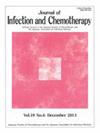Impact of the COVID-19 pandemic on the regional epidemiology of methicillin-resistant Staphylococcus aureus in the Kumamoto region
IF 1.5
4区 医学
Q3 INFECTIOUS DISEASES
引用次数: 0
Abstract
The COVID-19 pandemic caused the collapse of various health systems globally. Several studies have examined the impact of the increase in COVID-19 patients on antimicrobial resistance, but conclusions are controversial. This study aimed to clarify the impact of the COVID-19 pandemic on MRSA trends in the Kumamoto region. We analyzed the detection trends of MRSA using bacterial surveillance data from facilities in the Kumamoto Healthcare-associated Infection Prevention and Control Network from 2017 to 2022. Compared to pre-pandemic data, MRSA detection rates since 2020 have decreased. This was thought to be due to a decrease in the number of bacteriological tests of respiratory specimens, in which MRSA was frequently detected before the pandemic. On the other hand, that of skin and soft tissue specimens were not affected by the pandemic. The MRSA detection rate in these specimens showed a downward trend, suggesting that the increased awareness of infection control measures, including hand hygiene during the pandemic possibly had an impact. We further performed POT method analysis using a clinically isolated MRSA library from Kumamoto University Hospital. The monthly detection rate of the predominant POT type fluctuated from FY2020 to FY2022, and this clonal shift may have contributed to the decline in the MRSA detection rate in the Kumamoto region during the pandemic period. Throughout the pandemic, MRSA clones continued to evolve. Notably, the prevalence of clone 106-247-33, which was dominant in the early phase, may have fluctuated, potentially in relation to variations in the stringency of infection control measures. Therefore, further reductions in MRSA can be expected with maintaining robust implementation of infection control.
2019冠状病毒病疫情对熊本地区耐甲氧西林金黄色葡萄球菌区域流行病学的影响
COVID-19大流行导致全球各种卫生系统崩溃。几项研究调查了COVID-19患者增加对抗菌素耐药性的影响,但结论存在争议。本研究旨在阐明COVID-19大流行对熊本地区MRSA趋势的影响。我们利用熊本医疗保健相关感染预防和控制网络2017年至2022年设施的细菌监测数据分析了MRSA的检测趋势。与大流行前的数据相比,自2020年以来MRSA的检出率有所下降。这被认为是由于呼吸道标本的细菌学检测次数减少,在大流行之前经常检测到耐甲氧西林金黄色葡萄球菌。另一方面,皮肤和软组织标本没有受到大流行的影响。这些标本的MRSA检出率呈下降趋势,表明疫情期间加强对感染控制措施(包括手卫生)的认识可能产生了影响。我们进一步使用熊本大学医院临床分离的MRSA文库进行POT方法分析。从2020财年到2022财年,主要POT型的月检出率波动,这种克隆转移可能是造成大流行期间熊本地区MRSA检出率下降的原因。在整个大流行期间,MRSA克隆继续进化。值得注意的是,在早期阶段占主导地位的克隆106-247-33的流行率可能有所波动,这可能与感染控制措施的严格程度不同有关。我们的研究表明,在大流行期间熊本地区观察到特定标本的检出率下降和MRSA的克隆转移。因此,通过保持感染控制的强有力实施,可以预期MRSA的进一步减少。
本文章由计算机程序翻译,如有差异,请以英文原文为准。
求助全文
约1分钟内获得全文
求助全文
来源期刊

Journal of Infection and Chemotherapy
INFECTIOUS DISEASES-PHARMACOLOGY & PHARMACY
CiteScore
4.10
自引率
4.50%
发文量
303
审稿时长
47 days
期刊介绍:
The Journal of Infection and Chemotherapy (JIC) — official journal of the Japanese Society of Chemotherapy and The Japanese Association for Infectious Diseases — welcomes original papers, laboratory or clinical, as well as case reports, notes, committee reports, surveillance and guidelines from all parts of the world on all aspects of chemotherapy, covering the pathogenesis, diagnosis, treatment, and control of infection, including treatment with anticancer drugs. Experimental studies on animal models and pharmacokinetics, and reports on epidemiology and clinical trials are particularly welcome.
 求助内容:
求助内容: 应助结果提醒方式:
应助结果提醒方式:


